Carbon Footprint
What is it?
A carbon footprint is defined as: The total amount of greenhouse gases produced to directly and indirectly support human activities, usually expressed in equivalent tons of carbon dioxide (CO2). In other words: When you drive a car, the engine burns fuel which creates a certain amount of CO2, depending on its fuel consumption and the driving distance. (CO2 is the chemical symbol for carbon dioxide). When you heat your house with oil, gas or coal, then you also generate CO2. Even if you heat your house with electricity, the generation of the electrical power may also have emitted a certain amount of CO2. When you buy food and goods, the production of the food and goods also emitted some quantities of CO2. Your carbon footprint is the sum of all emissions of CO2 (carbon dioxide), which were induced by your activities in a given time frame. Usually a carbon footprint is calculated for the time period of a year.
http://timeforchange.org/what-is-a-carbon-footprint-definition
Carbon footprint foot
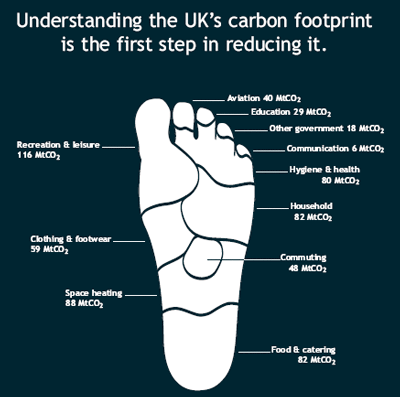
Carbon Footprint Foot - Click here for a larger image
Image 1, breakdown of a typical person’s carbon output,
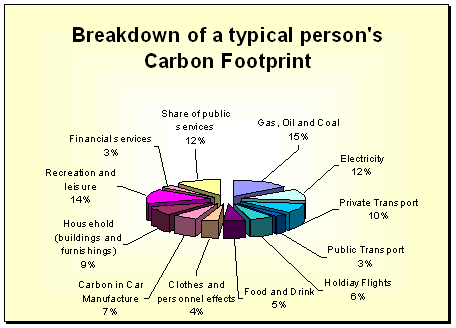
Carbon Footprint Breakdown - Click here for a larger image
Image 10, earth’s footprint,
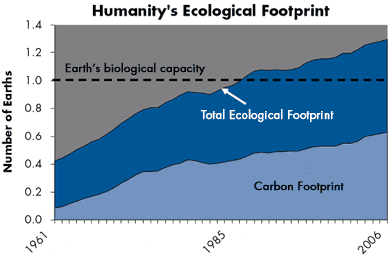
Earth's Footprint - Click here for a larger image
Whenever human activities involve the burning of fossil fuels, carbon dioxide is emitted. This waste will accumulate in the atmosphere, contributing to global climate change, unless it can be captured and stored by plants. The carbon Footprint therefore measures the demand on biocapacity that results from burning fossil fuels in terms of the amount of forest area required to sequester these carbon dioxide emissions. Note that this does not suggest planting forests is the 'solution' to climate change; on the contrary, it shows that the biosphere does not have sufficient capacity to sequester all the carbon we are currently emitting.
Humanity's carbon Footprint has grown much faster than any other Footprint component, increasing more than nine fold since 1961 and now comprising about half the total demand we place on nature's regenerative capacity. With our overall Footprint now exceeding global biocapacity by about 30%, reducing our carbon Footprint is essential if we want to get out of overshoot. To be effective, however, this must be done in a careful, Footprint-neutral manner, and not simply by transfering demand from one Footprint component to another. For example, biofuels can be substituted for fossil fuels, but this requires cropland to grow the necessary biomass. If the resultant decrease of carbon Footprint is more than compensated for by an increase in the cropland Footprint, overshoot will grow rather than shrink.
Recently the term 'carbon Footprint' has been adopted as a shorthand for the amount of carbon (usually in tonnes) being emitted by an organization or activity. The carbon component of the Ecological Footprint differs in that it goes beyond simply describing the physical quantity of carbon being emitted, instead indicating the amount of nature's limited regenerative capacity required to get this carbon back out of the atmosphere.
http://carbon_footprint
Examples:
- For each gallon of petrol fuel consumed, 10.4 kg carbon dioxide (CO2) is emitted.
- If your car consumes 7.5 liter diesel per 100 km, then a drive of 300 km distance consumes 3 x 7.5 = 22.5 liter diesel, which adds 22.5 x 2.7 kg = 60.75 kg CO2 to your personal carbon footprint.
fuel type |
unit |
CO2 emitted per unit |
Petrol |
1 gallon |
10.4 kg |
Petrol |
1 liter |
2.3 kg |
Diesel |
1 gallon |
12.2 kg |
Diesel |
1 liter |
2.7 kg |
Oil (heating) |
1 gallon |
13.6 kg |
Oil (heating) |
1 liter |
3 kg |
Each of the following activities add 1 kg of CO2 to your personal carbon footprint:
- Travel by public transportation (train or bus) a distance of 10 to 12 km (6.5 to 7 miles)
- Drive with your car a distance of 6 km or 3.75 miles (assuming 7.3 litres petrol per 100 km or 39 mpg)
- Fly with a plane a distance of 2.2 km or 1.375 miles.
- Operate your computer for 32 hours (60 Watt consumption assumed)
- Production of 5 plastic bags
- Production of 2 plastic bottles
- Production of 1/3 of an American cheeseburger (yes, the production of each cheeseburger emits 3.1 kg of CO2!)
http://timeforchange.org/what-is-a-carbon-footprint-definition
Image 2, This graph shows the amount of Carbon Dioxide in the atmosphere
during the last 400,000 years until 1950,
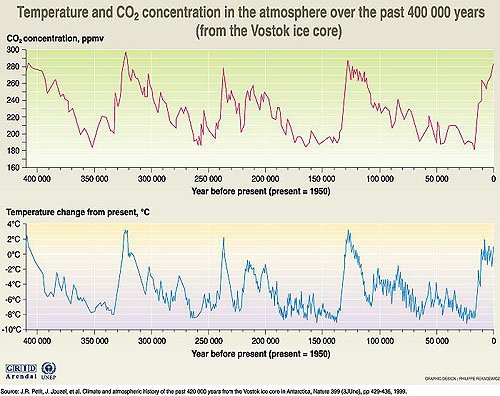
Carbon Dioxide - Click here for a larger image
http://www.carbonfootprint.com/faq.html
Image 3, This graph shows the amount of CO2 in the atmosphere during the last 10,000 years leading up to 2005, where the levels reach 370 ppm,
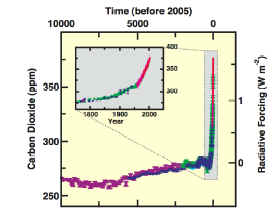
Carbon Dioxide - Click here for a larger image
http://www.carbonfootprint.com/faq.html
Image 11-13, various graphs on page

Graph1 - Click here for a larger image

Graph2 - Click here for a larger image

Graph3 - Click here for a larger image

Graph4 - Click here for a larger image
DISPOSABLE RAZOR COUNTER OF DOOM - CLICK HERE
Disposable Razors
In the United States alone, people buy over two billion disposable razors and blades each year. Imagine the non-degradable razors sitting in landfills across America. Additionally, Every one of the razors produced also emits CO2 as a byproduct.
http://www.eco-action.net/pollution.html
The production of plastic, the material used in the disposable razors around the world, is a heavy contributor into the growing CO2 problem. The production of five grocery plastic bags or two regular sized plastic water bottles both contribute one kilogram of CO2 into the atmosphere. Taking into consideration the massive quantities of disposable razors that are tossed out every year, one can truly surmise the shear tonnage of unwanted gases produced because of the short life span of disposable razors.
With Razor Gator™, the short life span of the ordinary disposable razor is extended for the user and the sustainability of our culture is enhanced.
image, bag of bic disposable razors,

Disposable Razors - Click here for a larger image
IM.0884_zp.jpg
How does Razor Gator reduce your Carbon Footprint?
Global warming affects all of us.
The production of billions of disposable
razors brings with it the cost of increased
CO2 emissions. Woah. There goes another
glacier.
Razor Gator is doing its part to make your
razors last longer so you don't have to
throw them away as quickly. Less razors
used means less razors made and reduce CO2
emissions. Do your part, Use Razor Gator----your
country and Razor Gator will love you, and
so will your skin.
How is your Carbon Footprint calculated?
A Carbon Footprint is made up of the sum of two parts, the direct / primary footprint and the indirect / secondary footprint.
1. The primary footprint is a measure of our direct emissions of CO2 from the burning of fossil fuels including domestic energy consumption and transportation (e.g. car and plane).
2. The secondary footprint is a measure of the indirect CO2 emissions from the whole lifecycle of products we use - those associated with their manufacture and eventual breakdown.
http://www.carbonfootprint.com/carbonfootprint.html
Carbon Calculators
http://www.carbonfootprint.com/calculator.aspx
http://www.nature.org/initiatives/climatechange/calculator/
http://www.climatecrisis.net/takeaction/carboncalculator/
http://www.carboncalculator.co.uk/calculator.php
Image 15, carbon calculator,
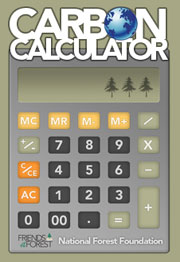
Carbon Calculator - Click here for a larger image
http://www.becomeafriend.org/images/calculator.jpg
Effects of the Carbon Buildup
It's well known that carbon dioxide is a greenhouse gas, but just what does this mean, and what are the possible consequences of global warming?
Radiation from the Sun heats Earth's atmosphere, oceans and land, making life on Earth possible. The incoming radiation can easily pass through the outer atmosphere in order to reach the Earth, but much of it cannot escape as the atmosphere acts as a one way valve. Exactly how much of the radiation escapes the atmosphere depends on the concentration of greenhouse gases (including carbon dioxide, methane etc) present. However, the so-called greenhouse effect is not a bad thing as such - without it, the temperature of the surface of the Earth would be -18°C, instead of the actual value of about 15°C. So what's all the fuss about?
The main worry is that, as previously mentioned, the amount of radiation which escapes depends on the concentration of greenhouses gases in the atmosphere - carbon emissions add to the concentration, meaning that less radiation escapes. This means that the surface temperature of the Earth increases - by 0.6°C ± 0.2°C over the last century. This may not sound like much, but the warming will increase with time, and could have disastrous consequences. These might include:
· Sea level rise - densely settled coastal plains would become uninhabitable with just a small rise in sea level, which would result from melting of the ice caps
· Impacts on agriculture - Global warming could have major effects on agricultural productivity
· Reduction of the ozone layer - Warming would result in increase high cloud cover in winter, giving chemical reactions a platform in the atmosphere, which could result in depletion of the ozone layer
· Increased extreme weather - A warmer climate could change the weather systems of the earth, meaning there would be more droughts and floods, and more frequent and stronger storms
· Spread of diseases - Diseases would be able to spread to areas which were previously too cold for them to survive in
· Ecosystem change - As with the diseases, the range of plants and animals would change, with the net effect of most organisms moving towards the North and South Poles
As you can see, the effects of carbon dioxide emissions could be extremely far reaching and cause major problems. Even a small reduction in household emissions could help to alleviate the problems future generations are likely to face.
http://www.carboncalculator.co.uk/effects.php
Image 4, picture of the greenhouse gas output across the globe,
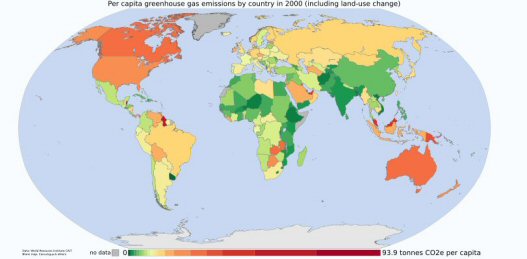
Greenhouse Gas - Click here for a larger image
GHG_per_capita_2000.svg
Image 5, impact of sea level raise in south florida,
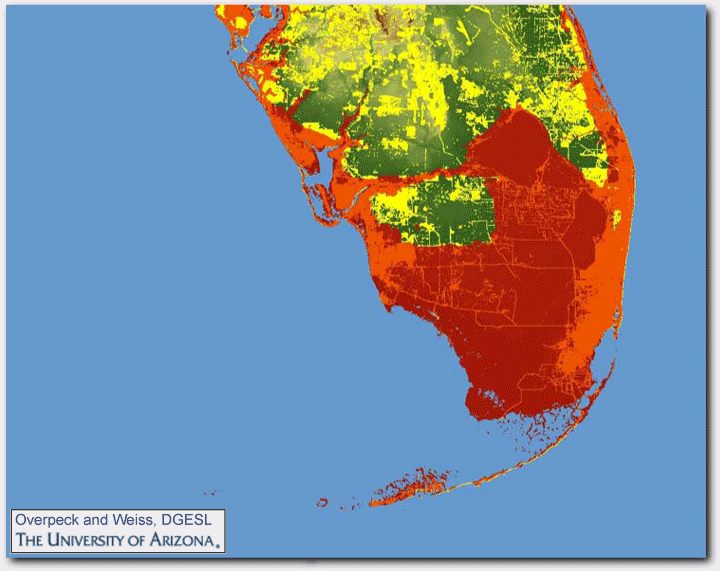
Sea Level Raise - Click here for a larger image
southernflorida.gif
Image 6, Ozone reduction,
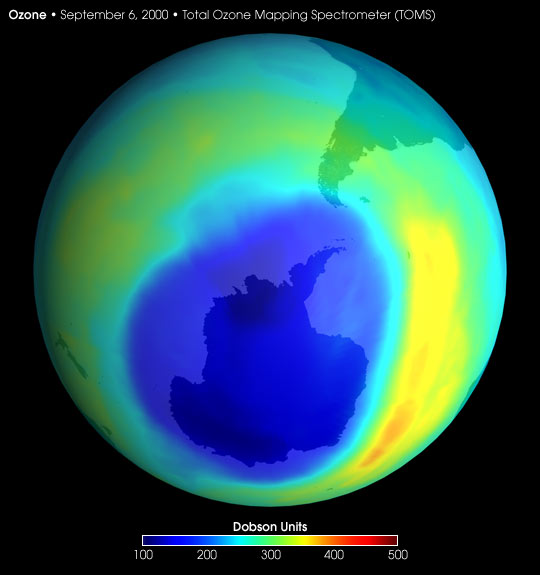
Ozone Reduction - Click here for a larger image
2000_09_06.jpg
Image 7, hurricane 2004,

Hurricane - Click here for a larger image
http://blogs.bootsnall.com/Seafarer/wp-content/uploads/2006/05/floridapostcard.jpg
Global Dimming
Since the 1950s sunlight reaching the Earth has significantly reduced. In Israel, where the first measurements were taken, sunlight intensity has reduced by some 22% and in the UK it has reduced by about 10%.
Why is this important? Global dimming causes a drop in temperature around the world that can upset established climates - altering season length and characteristics, and change the Earth's monsoon patterns. Scientists believe that global dimming was a key cause of the Ethiopian droughts back in the 1980s.
Does Global Dimming counteract Global warming? Global Dimming can, and actually has, slowed the effects of Global Warming. However, the Earth's population is now doing something about the amount of carbon particulates being released in to the atmosphere, by fitting catalytic converters to cars and reducing emissions from power stations etc. Many scientists now believe that the rate of global warming has been significantly underestimated because of global dimming, and global warming will accelerate giving us even less time than originally thought to take action.
http://www.carbonfootprint.com/dimming.html
Image 8, global dimming skyline,

Global Dimming - Click here for a larger image
http:/Hong%20Kong%20blog.JPG
Sustainability
Sustainability is a simple idea. It is based on the recognition that when resources are consumed faster than they are produced or renewed, the resource is depleted and eventually used up. In a sustainable world, society's demand on nature is in balance with nature's capacity to meet that demand.
When humanity's ecological resource demands exceed what nature can continually supply, we move into what is termed ecological overshoot. According to a report by the World Resources Institute, the United Nations Environment Programme, the United Nations Development Programme, and the World Bank, World Resources 2000-2001, People and Ecosystems: The Fraying Web of Life, in addition to the growing depletion of non-renewable resources such as minerals, ores and petroleum, it is increasingly evident that renewable resources, and the ecological services they provide, are at even greater risk. Examples include collapsing fisheries, carbon-induced climate change, species extinction, deforestation, and the loss of groundwater in much of the world.
We depend on these ecological assets to survive. Their depletion systematically undermines the well being of people. Livelihoods disappear, resource conflicts emerge, land becomes barren, and resources become increasingly costly or unavailable. This depletion is exacerbated by the growth in human population as well as by changing lifestyles that are placing more demand on natural resources.
http://footprint_overview
Reducing the Carbon Footprint
Tips to Reduce Your Primary Footprint
1. Holidays
Don't go by air
2. Electricity
Sign up to renewable energy
3. Gas
Try using solar water heating - this can reduce your gas bill by up to 70% over a year.
4. Travelling around
Use public transport as much as possible. Find out about your local bus services and then use it.
5. Car Share
Sign up to a car share scheme to reduce your travel footprint.
Image 14, carpool,
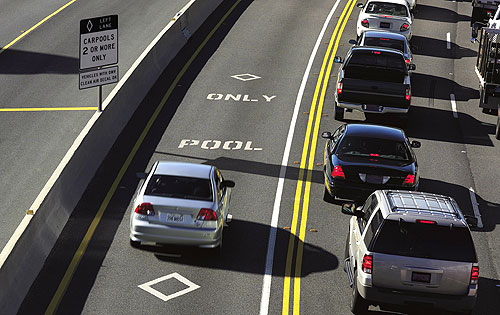
Carpool - Click here for a larger image
http://05.gx.carpool.lane.500.jpg
Tips to Reduce Your Secondary Footprint
When you buy goods - consider where they have been made and the materials and processes used to make them. Items that have high emissions in the manufacture or delivery should be avoided when ever possible. Things such as:-
1. Bottled water
Tap water is safe to drink in most European and North American countries, yet people still insist on buying bottled water. If the bottle is labelled as being from volcanic springs - you can bet that it has probably been imported from some distance. Imagine the carbon footprint of the flight / shipping of the water! And that's before adding in the emissions due to making the bottle and / or recycling it.
2. Food and drink from far distances
When you go to the supermarket, look at the label to identify which country the food is from. There is no need to buy New Zealand apples in the UK in the autumn - but people do!
Think twice about buying a bottle of wine from the other side of the world - you may be able to find much more local wine, which will have travelled far fewer miles.
Better still try growing your own fruit and vegetables in your own garden. Planting an apple tree will not only provide you with lots of fruit, with zero carbon footprint, but the tree itself with breathe in carbon dioxide from the atmosphere - making these fruit effectively carbon negative!
3. Meat eating
Reduce your consumption of meat, especially red meat.
4. Clothes from far off lands
Check the clothes labels before you buy. If they come from more than 1000 miles away, keep looking!
5. High packaged items
Avoid goods and services that have unnecessary packaging! Need we say more?
http://www.carbonfootprint.com/carbonfootprint.html
Image 9, anti-bottled water,
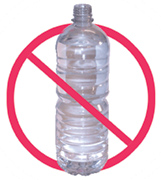
No Water Bottle - Click here for a larger image
h06.jpg
Image 17, carbon footprint poster,

Reduce your Carbon Footprint- Click here for a larger image
httpvinyl_pile.gif
More Ways
10 Cool Climate-Saving Actions
1. Save Energy
Save money and help the climate. Switch to ENERGY STAR qualifying compact fluorescent light bulbs, draft-proof your windows and doors, turn in your top loading washing machine for a new, efficient front-loader, and air dry your laundry (check out www.laundrylist.org). For home improvement resources which go beyond draft-proofing windows, visit the ENERGY STAR web site: www.energystar.gov/homeimprovement. Also, consider ceiling fans that push warm air to the floor in the winter and help circulate cool air in the summer. Appliances such as refrigerators, dishwashers and water heaters can be energy hogs. If you are in the market for a new appliance, look for the ENERGY STAR label-these appliances use 20-40 percent less energy than standard products. There are over 35 product categories that bear the ENERGY STAR, including light bulbs, ceiling fans, and appliances.
Procurement resources are available for businesses, municipalities, and colleges to help them buy ENERGY STAR products.
The Northeast Sustainable Energy Association (NESEA) has more on improving saving energy at home.
2. Think Before You Drive, and Offset Your Car's Emissions
On average, every gallon of gasoline burned emits about 20 pounds of carbon dioxide - which adds up to several times your car's weight in carbon dioxide every year.
First, don’t idle; turn off your car even while doing quick errands (it’s better for your car, anyway!) Likewise, skip the drive-through; park and go inside instead. Try walking, taking public transportation or riding a bike. Make a personal pledge to cut down on unnecessary car trips and have your vehicle serviced regularly to keep the emission control systems operating at peak efficiency.
When it comes to your vehicle, opt for non-petroleum fuels like biodiesel, made from waste vegetable oils and better for diesel engines than regular fuel. Shoot for 30 miles per gallon the next time you buy a car - consider perhaps a fuel-efficient hybrid vehicle that get as much as three times as many miles to the gallon.
Even after you do the items above, you’ll still be putting a lot of CO2 in the air. Visit www.CoolDriver.org, a partnership of Clean Air-Cool Planet and NativeEnergy, to learn how easy it is compensate for your car’s emissions, by helping build new Native American and family farmer-owned clean energy sources. The clean energy projects you help build with CoolDriverSM will reduce emissions on your behalf, eliminating your car’s contribution to global warming. You can Put the Brakes on Global Warming!SM
Want more? Try the U.S. Department of Energy for fuel economy info, check out the National Biodiesel Board, or look at the Green Car Journal.
3. Recycle
It really makes a difference. Make the extra effort to rinse out your spaghetti sauce jars, soup cans, and plastic soda bottles. Composting food waste for the garden helps return valuable nutrients to the soil. Remember, the more you recycle, the less waste goes to the landfill.
4. Buy Recycled Products
In many cases, products made from recycled materials require less energy to produce as compared to those made from virgin materials. For example it takes 75% less energy to make steel items from recycled steel. Another thing to look for is the recycled content of office paper-look for a minimum of 30 percent POST CONSUMER WASTE, not just recycled. And finally purchase the goods with less packaging-this means less energy to produce the package, less waste that goes to the landfill, and fewer trips to the curb to dispose of your trash.
Image 18, recycle,

Recycle - Click here for a larger image
http://www.bserecycling.com/images/recycle.jpg
5. Choose Green Electricity
Most electricity comes from the burning of fossil fuels like coal, oil and gas. In states with electricity deregulation, you can choose the company that supplies power to your home or business. Many utilities are beginning to offer consumers the choice to purchase green electricity, which is generated by wind and solar power. Call your utility and see if this option is available to you. Ask to be notified when it is. If you can’t buy green electricity through your utility, support renewable energy development by offsetting the pollution caused by your electricity use.
Learn more about how can get the benefits of renewable electricity at the websites for Green-E and NativeEnergy.
6. Use your Consumer Power
You can make a big difference just by making informed choices about the products and services you buy. Use businesses that make an effort to protect the climate and which stock climate- friendly products. Be sure to let them and their competitors know why you make the choices you do. Buy local produce whenever possible. When food does not have to travel great distances by road or air fewer greenhouse gas emissions are emitted during transport to market. Think before you Buy.
Want more information on what companies or products are the most environmentally and socially responsible? Check out these great resources: The Green Guide and Ideals Work.
7. Educate Yourself about Climate Change
Don't believe everything you read in the newspapers or see on the television. Some Washington lobbyists spend a lot of time and considerable amounts of money trying to confuse the issue. Use Clean Air - Cool Planet's website our Science and Policy, Additional Resources, and Program pages to get started and in find ing out what scientists, business people and economists are really saying.
8. Let Your Elected Representatives Know You Care
Write to your representatives in Congress and in the state legislature and tell them that clearing the air and slowing global warming are important to you. Urge them to support actions to reduce carbon pollution, save energy and expand the use of renewable energy.
Don’t know who your officials are or how to contact them? Get all of the info you need from Capitol Advantage.
Image19, capitol,

Capitol - Click here for a larger image
http://www.flykending.dk/tema/museer/nasm/capitol1.JPG
9. Create a Climate Friendly Environment
Initiate a Green Group on the job or in the neighborhood to investigate issues such as recycling and energy efficiency. Look into the assistance available through The EPA's Green Lights or Climate Wise programs. Make sure office equipment like photocopiers and computers are Energy Star compliant. Ask your employer to consider employee benefits for commuting by bicycle or mass transit.
10. Get Involved
Give a talk, or invite a guest speaker to your local school, place of worship or library. Start a local initiative aimed at reducing the community's impact on climate or get the issue on the agenda for a town meeting discussion. Support environmental non-profit groups working to slow global warming. You can become a member, take part in events like Earth Day or participate in letter- writing campaigns. Of course you can also support Clean Air-Cool Planet by making a tax-deductible donation.
http://www.cleanair-coolplanet.org/action/solutions.php